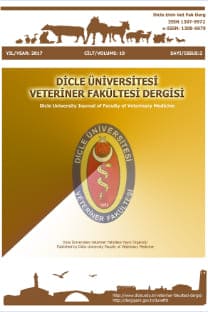Gökkuşağı Alabalıklarında (Oncorhynchus mykiss) Enrofloksasinin Artan Dozlarda Uygulanmasının Biyokimyasal ve Histopatolojik Parametrelere Etkisi
Biyokimyasal parametreler, enrofloksasin, gökkuşağı alabalığı, histopatoloji
___
- 1. Vignesh R, Karthikeyan B, Periyasamy N, Devanathan K. (2011). Antibiotics in Aquaculture: An Overview. South Asian J Exp Biol. 1: 114-120.
- 2. Quesada SP, Paschoal JA, Reyes FG. (2013). Considerations on The Aquaculture Development and on the Use of Veterinary Drugs: Special Issue for Fluoroquinolones--a Review. J Food Sci. 78(9): 1321-1333.
- 3. Amal MNA, Zamri-Saad M. (2011). Streptococcosis in Tilapia (Oreochromis niloticus): a Review. Pertanika J Trop Agric Sci. 34(2): 195-206.
- 4. Cabello FC. (2006). Heavy Use of Prophylactic Antibiotics in Aquaculture: a Growing Problem for Human and Animal Health and for the Environment. Environ Microbiol. 8(7): 1137-1144.
- 5. Sarkozy G. (2001). Quinolones: a Class of Antimicrobial Agents. Vet Med–Czech. 46(9-10): 257-274.
- 6. Trouchon T, Lefebvre S. (2016). A Review of Enrofloxacin for Veterinary Use. Open J Vet Med. 6: 40-58.
- 7. Pallo-Zimmerman LM, Byron JK, Graves TK. (2010). Fluoroquinolones: Then and Now. Compend Contin Educ Vet. 32(7): 1-9.
- 8. Samuelsen OB. (2006). Pharmacokinetics of Quinolones in Fish: A Review. Aquaculture. 255 (1-4): 55-75.
- 9. Capkin E, Terzi E, Altinok I. (2015). Occurrence of Antibiotic Resistance Genes in Culturable Bacteria Isolated from Turkish Trout Farms and Their Local Aquatic Environment. Dis Aquat Org. 114: 127-137.
- 10. Sekkin S, Kum C. (2011). Antibacterial Drugs in Fish Farms: Application and Its Effects. In: Recent Advances in Fish Farms. Aral DF (Ed.). InTechOpen, pp. 217-250.
- 11. Zhao L, Cao HP, Chen H. (2013). Acute Toxicity of Enrofloxacin to Carassius auratus gibelio and Its Effects on Blood Biochemical Indexes. Chin J Zool. 48: 446-450.
- 12. Wang D, Li S, Lu T. (2016). Rule of Accumulation of Enrofloxacin in Acipenser baerii and Drug-Induced Damage to the Tissues. Exp Biol Med (Maywood). 241(17): 1977-1984.
- 13. Adikwu E, Deo O. (2012). Fluoroquinolones Reported Hepatotoxicity. Pharmacology and Pharmacy. 3: 328-336.
- 14. Elbe H, Dogan Z, Taslidere E, Cetin A, Turkoz Y. (2016). Beneficial Effects of Quercetin on Renal Injury and Oxidative Stress Caused by Ciprofloxacin in Rats: A Histological and Biochemical Study. Hum Exp Toxicol. 35(3): 276–281.
- 15. Maslanka T, Jaroszewski JJ, Chrostowska M. (2004). Pathogenesis of Quinolone-Induced Arthropathy: a Review of Hypotheses. Pol J Vet Sci. 7: 323-331.
- 16. Wang N, Nkejabega N, Hien NN, et al. (2009). Adverse Effects of Enrofloxacin When Associated with Environmental Stress in Tra catfish (Pangasianodon hypophthalmus). Chemosphere. 77(11): 1577-1584.
- 17. Liu B, Cui Y, Brown PB, Ge X, Xie J, Xu P. (2015). Cytotoxic Effects and Apoptosis Induction of Enrofloxacin in Hepatic Cell Line of Grass carp (Ctenopharyngodon idellus). Fish Shellfish Immun. 47(2): 639-644.
- 18. Velasco-Santamarίa YM, Cruz-Casallas PE. (2008). Behavioural and Gill Histopathological Effects of Acute Exposure to Sodium Chloride in Moneda (Metynnis orinocensis). Environ Toxicol Pharmacol. 25(3): 365-372.
- 19. Baskar T. (2014). Impact of Nitrite Toxicity on Histopathological Profile to Freshwater Fish, Cirrhinus Mrigala. Int J Eng Sci. 3(4): 42-47.
- 20. Koç F, Uney K, Atamanalp M, Tumer I, Kaban G. (2009). Pharmacokinetic Disposition of Enrofloxacin in Brown Trout (Salmo trutta fario) After Oral and Intravenous Administrations. Aquaculture. 295(1–2): 142-144.
- 21. Al-Nazawi MH. (2008). Effects of Enrofloxacin and Marbofloxacin Administration on Some Fertility Parameters of Male Chicken. JTUSCI. 1: 1-5.
- 22. Shoorijeh SJ, Tamadon A, Vahedi M, Behzadi MA. (2012). Hematological and Biochemical Alterations Due to Over Dosage of Enrofloxacin in Cats. Pak Vet J. 32(1): 73-76.
- 23. Tras B, Maden M, Baş AL, Elmas M, Yazar E, Civelek T. (2001). Investigation of Biochemical and Haematological Side-effects of Enrofloxacin in Dogs. J Vet Med. 48: 59-63.
- 24. Coskun D, Parlak K, Dik B, et al. (2018). Effect of Enrofloxacin on the Joint Fluid/Blood Oxidative Status and Organ Damage Markers. Annu Res Rev Biol. 25(3):17.
- 25. Altan F, Çorum O, Durna Çorum D, Üney K. (2018). Farklı Dozlardaki Marbofloksasinin Koyunlarda Biyokimyasal ve Hematolojik Parametreler Üzerine Etkileri. Eurasian J Vet Sci. 34(2): 71-76.
- ISSN: 1307-9972
- Yayın Aralığı: Yılda 2 Sayı
- Başlangıç: 2008
- Yayıncı: Dicle Üniversitesi Veteriner Fakültesi
Morkaraman Koyunlarında Erkek Eklenti Genital Bezleri Üzerinde Morfolojik ve Histolojik Araştırmalar
İsmail Şah HAREM, İsmail DEMİRCİOĞLU, Bestami YILMAZ
Kanatlı Sindirim Sisteminin Fonksiyonel Histolojisi
Yağmur Raziye KOÇAK, Tuğba ÖZAYDIN
Kedilerde Key-Gaskell Sendromu
Berna ERSÖZ KANAY, Özkan ÜNVER
İvesi Koyunlarında (Ovis aries) Bulbus Oculi’nin Morfometrik Yapısının İncelenmesi
İSMAİL DEMİRCİOĞLU, BESTAMİ YILMAZ
Fötal gelişim boyunca koyun ileumundaki Toll-like reseptör 2 ekspresyonu
Mehmet ÖZBEK, Emel ERGÜN, Levent ERGÜN, Feyzullah BEYAZ, Füsun ERHAN, Banu KANDİL, Nuh YILDIRIM, Özge ÖZGENÇ
İvesi Koyunlarda (Ovis aries) Bulbus Oculinin Makroanatomik ve Morfometrik Yapısı
İsmail DEMİRCİOĞLU, Bestami YILMAZ
Keklik (Alectoris chukar) Barsağında Ghrelin, Leptin ve Obestatin Dağılımı
Fötal gelişim Boyunca Koyun İleumundaki Toll like Reseptör 2 Ekspresyonu
Levent ERGÜN, Mehmet ÖZBEK, Nuh YILDIRIM, Feyzullah BEYAZ, Banu KANDIL, Füsun ERHAN, Özge ÖZGENÇ, Emel ERGÜN
